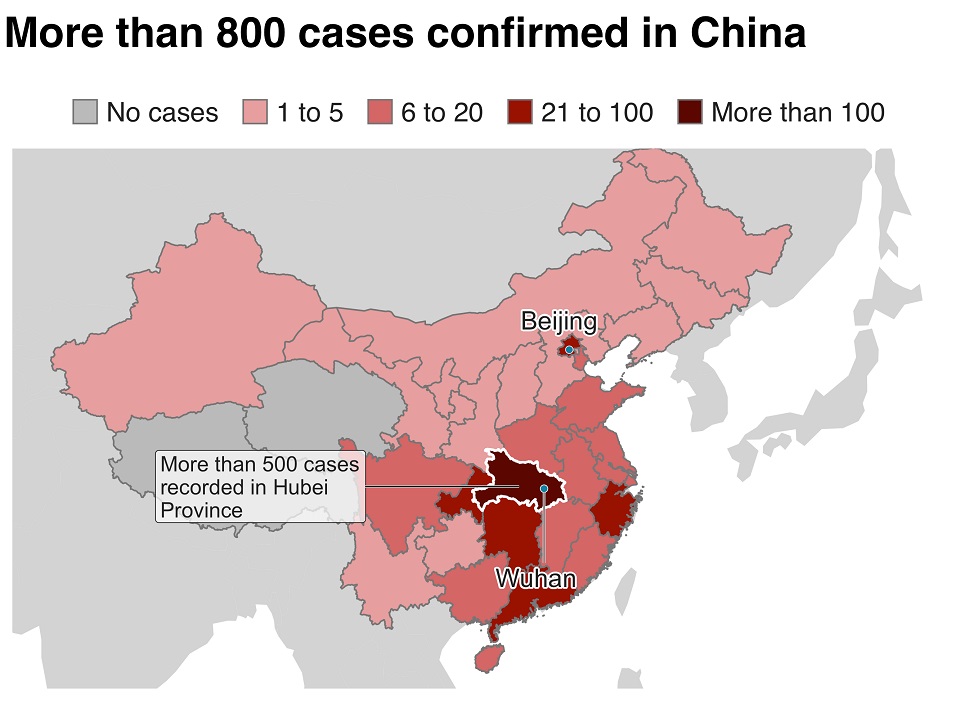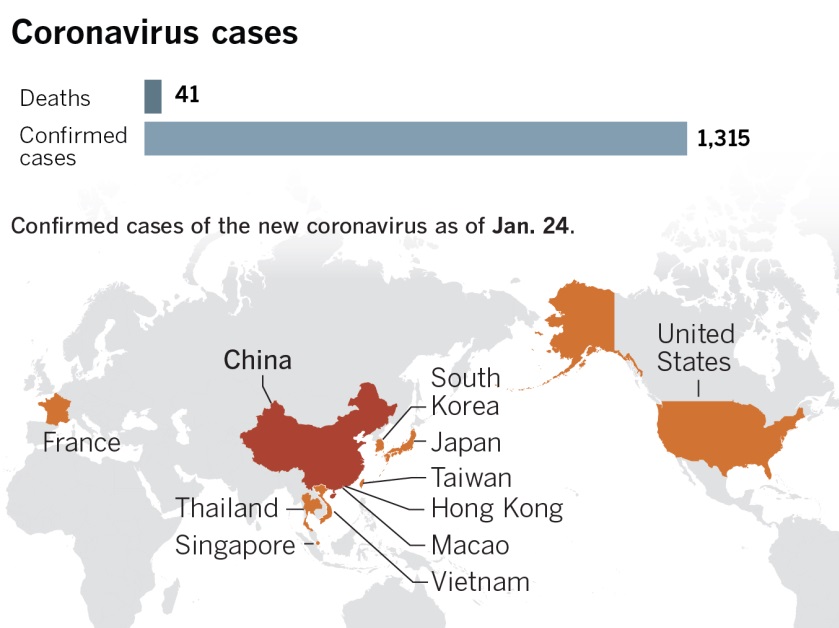Wuhan Lockdown Began a Year Ago, as Its Tourists Were Visiting Croatia
January 23, 2021 - The anniversary of the Wuhan lockdown a year ago today recalls a moment in time in the crazy timeline of 2020, when Wuhan tourists continued to visit Croatia.
They say that time is relative.
But that pearl of wisdom was coined before 2020.
Ordinarily, a single year would pass in the blink of an eye in the history of mankind, but 2020 lingered, its timeline so skewed, and totally different depending on your location.
We watched with incredulity as China imposed the Wuhan lockdown a year ago today, shutting down an entire city of 11 million people for weeks and confining them to their homes.
Closer to home, the images and daily death toll coming out of Italy were beyond belief. That could never happen to us, surely? I remember reading A letter to the UK from Italy: this is what we know about your future in March and feeling a chill go through my body. Ten months on,and the statistics speak for themselves.
The horror of the pandemic aside (and I don't think I was the only one to underestimate it), what struck me most about last year was the way time moved at various speeds. After Croatia had been in lockdown for some time in Spring, I received an angry email an American from Illinois. He was due to go on a cruise in Split the following month and could not get any information on whether or not it was going to happen.
His 2020 timeframe was a lot different to mine. For the realisation had not yet hit home. At time of writing, there were 5 deaths due to the virus in Illinois. Ten months later, more than 20,000. There have been no recent emails about cruise departures.
That concept of 2020 time was something I noted after the Zagreb earthquake when I recorded a piece for Robert Tomic Zuber's excellent R+ channel in late March. One of the only two certainties I noted was that everything in the video would be irrelevant the following week, as the world would have moved on. Again. And so it did.
As the Wuhan lockdown anniversary occurs, it is interesting to reflect on where things were in Croatia exactly one year ago, on January 23, 2020.
Even though TCN has written more than 1,800 articles on COVID-19 in the last year, there was no mention of the virus on the site on this day last year. That first mention came two days later, with Iva Tatic's What is Croatia Doing to Prevent the Spreading of the New Coronavirus? TCN was the first English portal in Croatia to write about coronavirus - by contrast, for example, there was no mention of it on the Ministry of Tourism's website until May.
That day, January 25, was notable in Croatia for another reason related to the pandemic. While the Wuhan lockdown was taking effect back home, Chinese tourists, including from Wuhan, were touring Croatia. It seems incredible looking back after the events of the last 12 months, but a party of 29 tourists landed in Milan on January 22, before heading to Plitvice Lakes, Zadar, overnighting in Neum in Bosnia (see video) and then on to Dubrovnik.

Ironically, last week I stopped at the same Neum restaurant on a business trip. After weeks of life in Croatia with no cafes or restaurants open, the chance of a mixed grill and a cold one was just too tempting. As I savoured my first restaurant meal in months, I reflected on the craziness of it all. A year later, so many opinions and expert voices, and we still could not agree on a uniform approach to battling the pandemic. As Bosnia, Montenegro and Albania had open restaurants and cafes, as well as a 22:00 curfew, everything remained shut without curfew in Croatia. Just one of the many differences in approach in just a handful of countries.
Whether or not the Wuhan tourists should have been allowed into Croatia is an easy debate to have with hindsight, but it is clear that the government's eye was not 100% on the health threat. Weeks later in March, Croatia would win global plaudits for its decisive intervention to control the pandemic, and new Health Minister Vili Beros was hailed a national hero for his pragmatic, no-nonsense approach. But a year ago, as the Wuhan lockdown started, Beros was a virtual unknown. Although he has rarely been out of the media since, he had not yet spent a year in the job. This time last year, the then Health Minister Milan Kujundzic, was spending most of his efforts trying to deflect attention away from his undeclared property portfolio. Efforts which were unsuccessful and ultimately cost him his job, paving the way for the start of Beros' ministerial career.
One year after the Wuhan lockdown, life has returned to relative normality, while in Croatia and most of the rest of the world, life is anything but normal. Just as we looked at incredulity at the Wuhan lockdown a year ago today, let's hope we are not looking at life in Wuhan today with pure envy 12 months from now.
Read more on the 2020 timeline in Croatia through Chinese eyes, with Zagreb resident Sisi (published on April 4, 2020) - Foreigners Self-Isolating in Croatia: Do You Feel Safer? Sisi from China in Zagreb.
For the latest on coronavirus in Croatia, follow the dedicated TCN section.
Chinese Tourists From Coronavirus Epicenter Wuhan City Arrive in Croatia
A bus of Chinese tourists from Wuhan, the Chinese city where the Coronavirus epidemic was first detected, recently arrived in Croatia. Just before noon yesterday, the bus reached the border crossing at Bregana.
*Follow this page for updates from Total Croatia News on the coronavirus in Croatia. Contact numbers for epidemiologists, travel advisories and measures for preventing the spread of the coronavirus can be found here.
According to reports, they arrived in Europe by plane to Milan, and arrived by bus to Croatia. Before their arrival in Croatia they were screened for signs of the virus at Milan airport. No one showed symptoms of the disease, as reported by Index on January 25,2020.
Chinese Tourist Bus Driver Advised by Croatian Epidemiologists
They stopped at Bregana and were instructed what to do if they notice symptoms. As Index learned, the bus driver also received the phone number of epidemiologists and must contact them if any passengers show any symptoms of the Coronavirus.

Croatian Institute of Public Health Issues Travel Advice for China
The Croatian Institute of Public Health was informed of the event and had previously issued precautions for travelers going to China and returnees or tourists from China, as reported by Iva Tatić/Total Croatia News on January 25, 2020. Those precautions follow below:
In view of the emergence of a new Coronavirus in China and the unknown about transmission routes, HZJZ advises international travelers traveling to affected areas to follow the usual precautions advised to reduce the risk of other travel-related diseases (i.e. alimentary infections which are transmitted by fecal-oral means or insufficiently processed foods, respiratory infections transmitted by aerosols and droplets, sexually transmitted diseases transmitted by unprotected sexual contact, blood-transmitted diseases transmitted by the sharing of drug and drug injection supplies).
- Avoiding close contact with people who have an acute respiratory infection.
- Frequent hand washing, especially after direct contact with people who are ill or while in their surroundings. If contact with an affected person cannot be avoided, use a surgical mask to cover your mouth and nose, do not touch your eyes, mouth of nose after contact with the patient. And mandatory washing and disinfection of hands after contact with the patient.
- Avoiding close contact with live or dead animals: both domestic and wild animals.
- Consuming properly processed foods, preferably immediately after preparation; thorough peeling of fruits and vegetables, drinking bottled water without ice.
- Avoidance of unprotected sexual intercourse with persons whose health status is unknown.
- Avoiding the sharing of drug paraphernalia (or illicit drugs) with others.
Health Precautions for Travel Returnees
Measures to reduce the spread of the disease on and upon return from the affected area:
- Passengers who have symptoms of acute respiratory infection should cover their nose and mouth with disposable wipes and wash their hands when coughing and sneezing.
- If an international traveler becomes ill, he/she is advised not to travel during the illness for several reasons: The demands of the journey may worsen his/her health. In some countries a passenger will not be allowed to board a means of transport (airplane, ship, train, bus) if he/she is recognized to be ill due to the possibility of transmitting the infection to other passengers.
- If the passenger becomes ill while traveling in a vehicle in international traffic, they should report their symptoms of the disease to staff to ensure that the patient remains comfortable and has the necessary protective equipment (surgical mask), medication (antipyretic, analgesic), and so that arrangements can be made for the patient with be met at the destination by the local health service.
- If a passenger develops fever and/or coughing and breathing difficulties within 14 days of leaving the affected area (at this time, Wuhan City is considered the only affected area), the doctor should be informed and informed that he/she has stayed in Wuhan for (or other affected area, if identified).
"The reason for promptly reporting a passenger with a fever with respiratory symptoms to a physician is to permit timely diagnosis and determine the true cause of the disease. It is much more likely that the returning traveler has the flu or other respiratory illness than the disease caused by the new Coronavirus. It also enables timely initiation of the proper treatment, prevention of further transmission of the disease to persons in close contact and ensures the necessary monitoring of the health persons who have been in close contact with the patient.
A returnee from the affected area may announce his/her arrival by telephone to the doctor to avoid staying in the waiting room and to arrange a way of arrival (it is not advisable for the patient to travel by public transport). If he/she does not know who to contact, the person may call the local epidemiologist or the epidemiologist of the Croatian Institute of Public Health for advice," the HZJZ advised.

What have scientists discovered about the Coronavirus so far?
The new Coronavirus has taken scientists by surprise according to Index on January 26, 2020. They do not know exactly where it originated, but it has already traveled 9500 kilometers since being discovered in China at the end of December. Despite quarantines, the epidemic is spreading. The number of fatalities is on the rise too.
If this was a Hollywood movie, now would be the time to panic. However, most people just need to wash their hands and continue going about their daily lives.
"Don't panic if you're not paid to panic," says epidemiologist Brandon Brown of the University of California, who has studied many deadly epidemics. "Health professionals need to be on standby and governments need to provide them with resources. Timely and accurate publicity is the key, and everyone else can relax," Brown adds.
Within three weeks of the outbreak, which spread to at least 941 people in 11 countries, scientists learned more about the virus. It is a Coronavirus, a relative of the pathogen causing Severe Acute Respiratory Syndrome (SARS) and Middle Eastern Respiratory Syndrome (MERS), a disease that has caused hundreds of deaths worldwide.
Other Coronaviruses cause nothing more severe than a cold. In addition to humans, Coronaviruses can infect cows, pigs, cats, chickens, camels, bats and other animals. Most of the initial victims of the current epidemic reported they had visited a large '' live market '' in the Chinese city of Wuhan, suggesting that the virus had passed from a different species to humans.
Coronavirus Causes Only Mild Symptoms in Young and Healthy
When experts examined the genetic code, they found a sequence previously unknown to science. This means that humans have not been able to develop natural immunity to the Coronavirus called n-CoV2019. Fortunately, it seems to only cause mild symptoms in young and healthy people. Most of the reported deaths are occurring in people over 50, those who have been previously ill or have weakened immune systems. "So far, we have no evidence that this is more dangerous than the flu. Most people will be fine with decent medical care," reports Michael Mina, an epidemiologist at Harvard.
"In fact, it is possible that hundreds or thousands of people have already been infected in China and elsewhere but have experienced such mild symptoms that no one has noticed," adds Tom Inglesby, director of the Johns Hopkins School of Public Health. "It's too early to know. In new outbreaks; the most severe cases are often identified first and can result in a distorted picture of how dangerous the situation is," Inglesby points out.
Information Updates Spreading Faster Than Coronavirus
Epidemiologists are now trying to find out when the new Coronavirus acquired the ability to transmit from person to person since the public market in Wuhan, which is considered the starting point, is clearly no longer the source of the epidemic's spread. Health workers expect human-to-human spread to continue in the short term, which means new cases will emerge across Asia, in the US and possibly in Europe. The news is that information about the virus is spreading faster than a virus.
The SARS epidemic erupted in 2002 in the Chinese province of Guangdong and by the time of its suppression in 2003; it had killed 774 people in 29 countries. The registered number of patients exceeded eight thousand. However, at the beginning of the crisis, the Chinese government was falsifying the number of sick people, refusing assistance from abroad, which undermined the ability of their own citizens to protect themselves. The public outrage led to the resignation of the Chinese Health Minister.
This time it's different. Chinese authorities quickly informed other countries of the epidemic's development. They also shared the genetic sequence of the virus, which can help epidemiologists track its spread and predict what to do next.
"This is definitely not 2003. The speed at which the virus was identified is a testament to that," adds Michael Mina from Harvard.
Scientists Develop Diagnostic Test Within 24 Hours
After receiving the Coronavirus genome, it took scientists 24 hours to develop a diagnostic test.This fact further supports the argument to avoid panic. The rapid increase in the number of patients can be misleading. Before the diagnostic test was developed, doctors had no reliable way of distinguishing n-CoV2019 virus infection from the virus causing pneumonia. And that means the number of registered cases will now skyrocket.
"You may hear about 300 new cases, but maybe 300 were before. An increase in the number of patients may not mean spreading the virus, but better detection," she added.
Follow our Lifestyle page for updates on the spread of Coronavirus and recommended protective measures for Croatia and abroad.
*Follow this page for updates from Total Croatia News on the coronavirus in Croatia. Contact numbers for epidemiologists, travel advisories and measures for preventing the spread of the coronavirus can be found here.
Wuhan Open: Petra Martic into Quarters against Ash Barty
September 25, 2019 - Petra Martic will play against the current best female tennis player in the world, Australian Ashleigh Barty, in the quarterfinal of the Wuhan Open.
Croatian tennis player Petra Martic has booked a spot in the quarterfinal of the WTA tournament in Wuhan! In the 3rd round match, Martic convincingly defeated Russian Veronika Kudermetova 6:3, 6:1 in just 58 minutes of play.
Martic broke her opponent in the fourth game, which was enough to take the first set. At 4:2, Croatia’s best female tennis player was faced with Kudermetova’s only chance to break in the first set of the match, though the Russian player made an error that blew her opportunity to return.
Already in the first game of the second set, Martic was up after Kudermetova missed an easy volley, and immediately in the next game, it was 15:40.
Kudermetova had three chances to break Petra in the match, though all three were saved.
Petra Martic storms into the @wuhanopentennis quarterfinal ?
— WTA (@WTA) September 25, 2019
She claims it, 6-3, 6-1 over Kudermetova. pic.twitter.com/bbzeTCKyUp
By moving forward, Petra has improved her WTA ranking - which is the best ranking of her career. Namely, Petra is now the 16th best tennis player in the world, and with a new stride and spot in the semifinal of the Wuhan Open, she would reach the top 15.
Martic will face a special challenge in the quarterfinal, as she awaits Australian Ashleigh Barty for the first time, who is also the world's best female tennis player.
To read more about sport in Croatia, follow TCN’s dedicated page.


